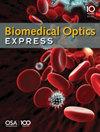利用线扫描仪进行深度分辨激光斑点对比成像的凝固深度估计
IF 2.9
2区 医学
Q2 BIOCHEMICAL RESEARCH METHODS
引用次数: 0
摘要
部分厚度烧伤的创面部分穿过真皮层,使许多痛觉感受器完好无损,从而使创面非常疼痛。由于疼痛难忍,快速评估烧伤深度非常重要,以免耽误必要的伤口手术。皮肤血流激光斑点成像(LSI)有助于发现血流受损的严重凝固区。不过,LSI 测量通常过于浅表,无法正确触及成人真皮层的全部深度,也无法分辨深度血流。漫射相关光谱(DCS)使用不同的源-检测器分离来区分血流深度,但需要耗时的二维扫描来形成烧伤区域的图像。我们在此介绍一种混合 DCS 和 LSI 技术的原型,称为斑点对比度漫反射相关光谱(scDCS),其新颖之处在于使用激光线作为光源,并利用平均图像的斑点对比度来估算组织中的静态散射。这样就可以通过快速非接触式一维扫描进行三维断层成像,对烧伤创面凝固区的深度和面积进行定量估计。体积流动模型和明胶楔形模型的模拟和实验结果表明,有望确定凝固深度。我们的目标是开发一种方法,将来可以对部分厚度烧伤创面的凝固深度进行更定量的估计,以便更好地估计何时需要手术。本文章由计算机程序翻译,如有差异,请以英文原文为准。
Coagulation depth estimation using a line scanner for depth-resolved laser speckle contrast imaging
Partial-thickness burn wounds extend partially through the dermis, leaving many pain receptors intact and making the injuries very painful. Due to the painfulness, quick assessment of the burn depth is important to not delay surgery of the wound if needed. Laser speckle imaging (LSI) of skin blood flow can be helpful in finding severe coagulation zones with impaired blood flow. However, LSI measurements are typically too superficial to properly reach the full depth of the adult dermis and cannot resolve the flow in depth. Diffuse correlation spectroscopy (DCS) uses varying source-detector separations to allow differentiation of flow depths but requires time-consuming 2D scanning to form an image of the burn area. We here present a prototype for a hybrid DCS and LSI technique called speckle contrast diffuse correlation spectroscopy (scDCS) with the novel approach of using a laser line as a source and using the speckle contrast of averaged images to obtain an estimate of static scattering in the tissue. This will allow for fast non-contact 1D scanning to perform 3D tomographic imaging, making quantitative estimates of the depth and area of the coagulation zone from burn wounds. Simulations and experimental results from a volumetric flow phantom and a gelatin wedge phantom show promise to determine coagulation depth. The aim is to develop a method that, in the future, could provide more quantitative estimates of coagulation depth in partial thickness burn wounds to better estimate when surgery is needed.
求助全文
通过发布文献求助,成功后即可免费获取论文全文。
去求助
来源期刊

Biomedical optics express
BIOCHEMICAL RESEARCH METHODS-OPTICS
CiteScore
6.80
自引率
11.80%
发文量
633
审稿时长
1 months
期刊介绍:
The journal''s scope encompasses fundamental research, technology development, biomedical studies and clinical applications. BOEx focuses on the leading edge topics in the field, including:
Tissue optics and spectroscopy
Novel microscopies
Optical coherence tomography
Diffuse and fluorescence tomography
Photoacoustic and multimodal imaging
Molecular imaging and therapies
Nanophotonic biosensing
Optical biophysics/photobiology
Microfluidic optical devices
Vision research.
 求助内容:
求助内容: 应助结果提醒方式:
应助结果提醒方式:


